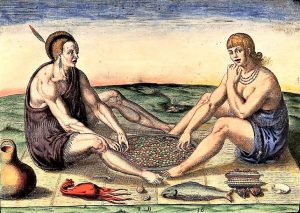 de Bry, Theodor; White, John. 1590. “Native American Man and Woman Eating (XVI. Their sitting at meate)” Roanoke, North Carolina. University of North Carolina. Library. Digital Collection: de Bry Engravings. Accessed October 05, 2018. https://dc.lib.unc.edu/cdm/singleitem/collection/debry/id/58/rec/18
de Bry, Theodor; White, John. 1590. “Native American Man and Woman Eating (XVI. Their sitting at meate)” Roanoke, North Carolina. University of North Carolina. Library. Digital Collection: de Bry Engravings. Accessed October 05, 2018. https://dc.lib.unc.edu/cdm/singleitem/collection/debry/id/58/rec/18
In his large collection of engravings, Theodor de Bry depicts many scenes of Native American interactions, but his engraving Native American Man and Woman Eating is especially good at illuminating the relationship between food and colonialism at the time. Though there are some questionable details about this specific engraving – such as the abnormally light complexion of the natives and the blonde hair of the female – the engraving still manages to capture some of the important staples in a Native American diet. Since Chapel Hill was not founded until over 200 years after the creation of these engravings, the area that is now Orange County could very well have been inhabited by Native Americans who would have looked and acted much like those depicted in some of de Bry’s work as well as in some of John White’s earlier works.[1] This means that traditions of a Native American tribe located in the coastal regions of North Carolina would have been different from the traditions of a tribe living in the western half of the state , but there would have also been key similarities. While many of these differences would have been found in the types of food available and in the way individuals would dress, the food was still gathered through hunting, fishing, and early forms of agriculture. [3]
This specific engraving depicts the scene where a Native American man and woman sit across from one another, eating food. Aside from a corn-like grain (this would have been maize at the time) located centrally between the two, there is also an urn, some form of red animal meat, a tobacco pipe, an opened walnut, a fish, and a seashell. Each one of the items in the engraving were important to the Native Americans in that location, but the most important of them all were the food items. Maize specifically is well known for being one of the most important Native American food staples during the colonial times, and as also being crucial to early colonizers of North Carolina. [2] This engraving ties into the Chapel Hill food story, because it is representative of what the area would have looked like socially, as well as the humble gastronomic beginnings the state of North Carolina was born from.
[1] Tucker, Abigail. “Sketching the Earliest Views of the New World”. Smithsonian Magazine. December, 2008. Accessed October 09, 2018. https://www.smithsonianmag.com/travel/sketching-the-earliest-views-of-the-new-world-92306407/
[2] Saenger, Tim. “Colonial Farming and Food: Famine to Prosperity” North Carolina State University. 2013. Accessed October 09, 2018. https://www.ncpedia.org/colonial-farming-and-food-famine
[3] Stick, David; Wallace, Vicki. “Indian Fishing and Hunting” National Park Service. 2015. Accessed October 09, 2018. https://www.nps.gov/fora/learn/education/indian-fishing-and-hunting.htm
Eli Graham